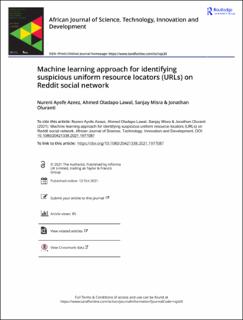| dc.contributor.author | Azeez, Nureni Ayofe | |
| dc.contributor.author | Lawal, Ahmed Oladapo | |
| dc.contributor.author | Misra, Sanjay | |
| dc.contributor.author | Oluranti, Jonathan | |
| dc.date.accessioned | 2022-01-21T11:18:22Z | |
| dc.date.available | 2022-01-21T11:18:22Z | |
| dc.date.created | 2021-10-27T13:05:24Z | |
| dc.date.issued | 2021 | |
| dc.identifier.citation | African Journal of Science, Technology, Innovation and Development. 2021. | en_US |
| dc.identifier.issn | 2042-1338 | |
| dc.identifier.uri | https://hdl.handle.net/11250/2838670 | |
| dc.description.abstract | The applications and advantages of the Internet for real-time information sharing can never be over-emphasized. These great benefits are too numerous to mention but they are being seriously hampered and made vulnerable due to phishing that is ravaging cyberspace. This development is, undoubtedly, frustrating the efforts of the Global Cyber Alliance – an agency with a singular purpose of reducing cyber risk. Consequently, various researchers have attempted to proffer solutions to phishing. These solutions are considered inefficient and unreliable as evident in the conflicting claims by the authors. Against this backdrop, this work has attempted to find the best approach to solving the challenge of identifying suspicious uniform resource locators (URLs) on Reddit social networks. In an effort to handle this challenge, attempts have been made to address two major problems. The first is how can the suspicious URLs be identified on Reddit social networks with machine learning techniques? And the second is how can internet users be safeguarded from unreliable and fake URLs on the Reddit social network? This work adopted six machine learning algorithms – AdaBoost, Gradient Boost, Random Forest, Linear SVM, Decision Tree, and Naïve Bayes Classifier – for training using features obtained from Reddit social network and for additional processing. A total sum of 532,403 posts were analyzed. At the end of the analysis, only 87,083 posts were considered suitable for training the models. After the experimentation, the best performing algorithm was AdaBoost with an accuracy level of 95.5% and a precision of 97.57%. | en_US |
| dc.language.iso | eng | en_US |
| dc.publisher | Taylor & Francis | en_US |
| dc.rights | Attribution-NonCommercial-NoDerivatives 4.0 Internasjonal | * |
| dc.rights.uri | http://creativecommons.org/licenses/by-nc-nd/4.0/deed.no | * |
| dc.subject | Internet | en_US |
| dc.subject | machine learning algorithms | en_US |
| dc.subject | phishing | en_US |
| dc.subject | Reddit | en_US |
| dc.subject | uniform resource locators | en_US |
| dc.title | Machine learning approach for identifying suspicious uniform resource locators (URLs) on Reddit social network | en_US |
| dc.type | Peer reviewed | en_US |
| dc.type | Journal article | en_US |
| dc.description.version | publishedVersion | en_US |
| dc.rights.holder | © 2021 The Authors. | en_US |
| dc.subject.nsi | VDP::Teknologi: 500::Informasjons- og kommunikasjonsteknologi: 550::Datateknologi: 551 | en_US |
| dc.source.pagenumber | 9 | en_US |
| dc.source.journal | African Journal of Science, Technology, Innovation and Development. | en_US |
| dc.identifier.doi | 10.1080/20421338.2021.1977087 | |
| dc.identifier.cristin | 1948892 | |
| cristin.ispublished | true | |
| cristin.fulltext | original | |
| cristin.qualitycode | 1 | |

